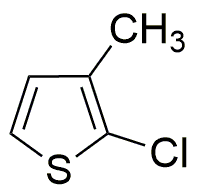2-Chloro-3-methylthiophene is widely utilized in research focused on:
- Pharmaceutical Development: This compound serves as an important intermediate in the synthesis of various pharmaceuticals, particularly in the development of anti-inflammatory and antimicrobial agents.
- Agricultural Chemicals: It is used in the formulation of agrochemicals, including pesticides and herbicides, enhancing crop protection and yield.
- Material Science: The compound is explored for its role in the development of conductive polymers, which are essential in electronics and sensor technologies.
- Flavor and Fragrance Industry: Its unique odor profile makes it a valuable ingredient in the formulation of specialty fragrances and flavoring agents.
- Research Applications: It is utilized in various chemical research projects, particularly in studies related to sulfur-containing compounds and their reactivity, providing insights into new synthetic pathways.
General Information
Properties
Safety and Regulations
Applications
2-Chloro-3-methylthiophene is widely utilized in research focused on:
- Pharmaceutical Development: This compound serves as an important intermediate in the synthesis of various pharmaceuticals, particularly in the development of anti-inflammatory and antimicrobial agents.
- Agricultural Chemicals: It is used in the formulation of agrochemicals, including pesticides and herbicides, enhancing crop protection and yield.
- Material Science: The compound is explored for its role in the development of conductive polymers, which are essential in electronics and sensor technologies.
- Flavor and Fragrance Industry: Its unique odor profile makes it a valuable ingredient in the formulation of specialty fragrances and flavoring agents.
- Research Applications: It is utilized in various chemical research projects, particularly in studies related to sulfur-containing compounds and their reactivity, providing insights into new synthetic pathways.
Documents
Safety Data Sheets (SDS)
The SDS provides comprehensive safety information on handling, storage, and disposal of the product.
Product Specification (PS)
The PS provides a comprehensive breakdown of the product’s properties, including chemical composition, physical state, purity, and storage requirements. It also details acceptable quality ranges and the product's intended applications.
Certificates of Analysis (COA)
Search for Certificates of Analysis (COA) by entering the products Lot Number. Lot and Batch Numbers can be found on a product’s label following the words ‘Lot’ or ‘Batch’.
*Catalog Number
*Lot Number
Certificates Of Origin (COO)
This COO confirms the country where the product was manufactured, and also details the materials and components used in it and whether it is derived from natural, synthetic, or other specific sources. This certificate may be required for customs, trade, and regulatory compliance.
*Catalog Number
*Lot Number
Safety Data Sheets (SDS)
The SDS provides comprehensive safety information on handling, storage, and disposal of the product.
DownloadProduct Specification (PS)
The PS provides a comprehensive breakdown of the product’s properties, including chemical composition, physical state, purity, and storage requirements. It also details acceptable quality ranges and the product's intended applications.
DownloadCertificates of Analysis (COA)
Search for Certificates of Analysis (COA) by entering the products Lot Number. Lot and Batch Numbers can be found on a product’s label following the words ‘Lot’ or ‘Batch’.
*Catalog Number
*Lot Number
Certificates Of Origin (COO)
This COO confirms the country where the product was manufactured, and also details the materials and components used in it and whether it is derived from natural, synthetic, or other specific sources. This certificate may be required for customs, trade, and regulatory compliance.


